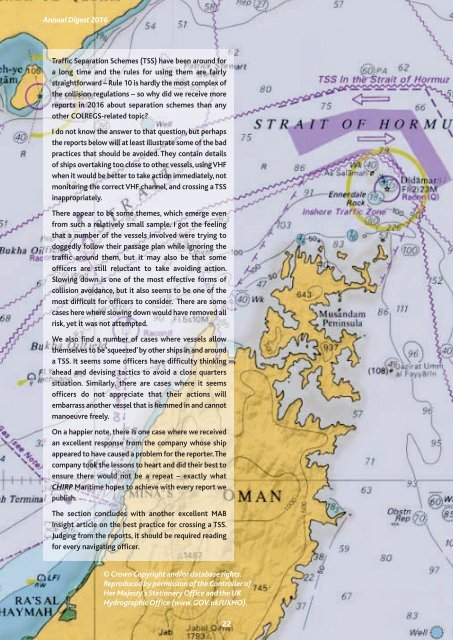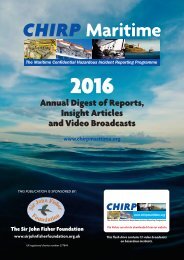CHIRP annual digest 2016 6th
Create successful ePaper yourself
Turn your PDF publications into a flip-book with our unique Google optimized e-Paper software.
Annual Digest <strong>2016</strong><br />
Traffic Separation Schemes (TSS) have been around for<br />
a long time and the rules for using them are fairly<br />
straightforward – Rule 10 is hardly the most complex of<br />
the collision regulations – so why did we receive more<br />
reports in <strong>2016</strong> about separation schemes than any<br />
other COLREGS-related topic?<br />
I do not know the answer to that question, but perhaps<br />
the reports below will at least illustrate some of the bad<br />
practices that should be avoided. They contain details<br />
of ships overtaking too close to other vessels, using VHF<br />
when it would be better to take action immediately, not<br />
monitoring the correct VHF channel, and crossing a TSS<br />
inappropriately.<br />
There appear to be some themes, which emerge even<br />
from such a relatively small sample. I got the feeling<br />
that a number of the vessels involved were trying to<br />
doggedly follow their passage plan while ignoring the<br />
traffic around them, but it may also be that some<br />
officers are still reluctant to take avoiding action.<br />
Slowing down is one of the most effective forms of<br />
collision avoidance, but it also seems to be one of the<br />
most difficult for officers to consider. There are some<br />
cases here where slowing down would have removed all<br />
risk, yet it was not attempted.<br />
We also find a number of cases where vessels allow<br />
themselves to be ‘squeezed’ by other ships in and around<br />
a TSS. It seems some officers have difficulty thinking<br />
ahead and devising tactics to avoid a close quarters<br />
situation. Similarly, there are cases where it seems<br />
officers do not appreciate that their actions will<br />
embarrass another vessel that is hemmed in and cannot<br />
manoeuvre freely.<br />
On a happier note, there is one case where we received<br />
an excellent response from the company whose ship<br />
appeared to have caused a problem for the reporter. The<br />
company took the lessons to heart and did their best to<br />
ensure there would not be a repeat – exactly what<br />
<strong>CHIRP</strong> Maritime hopes to achieve with every report we<br />
publish.<br />
The section concludes with another excellent MAB<br />
Insight article on the best practice for crossing a TSS.<br />
Judging from the reports, it should be required reading<br />
for every navigating officer.<br />
© Crown Copyright and/or database rights.<br />
Reproduced by permission of the Controller of<br />
Her Majesty’s Stationery Office and the UK<br />
Hydrographic Office (www.GOV.uk/UKHO).<br />
22



